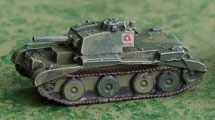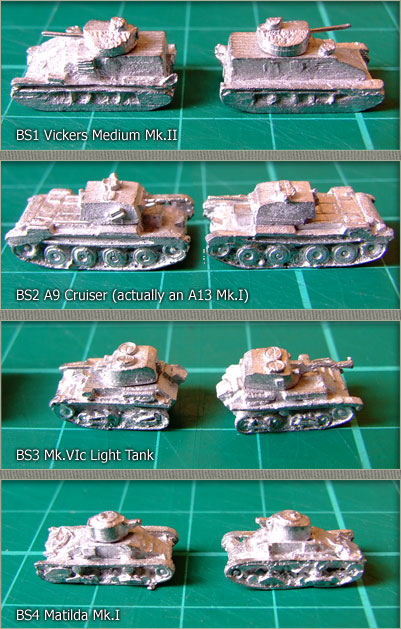
C-in-C version of the same vehicle for comparison

Larger images of each model are available here:
Scotia, in common with other British microarmour manufacturers, produce models in 1/300 scale, or 1mm to 1 foot. The American manufacturers like GHQ and C-in-C go for 1/285 scale. I have no idea why. Anyway, the difference between the two scales is perceptible, but as long as each unit is made up of one scale or the other, it's not really noticeable on the table.
These models are all from Scotia's WWII British range, and they're all very early war vehicles — in fact the Vickers Medium was well and truly obsolete by the beginning of the war, and had been relegated to training duties and to garrison work in some of the farther-flung parts of the Empire.
In terms of price and quality, these models from Scotia are comparable with those from NavWar/Heroics & Ros. The general profile of each vehicle is reasonably well rendered, and there is sufficient detail to distinguish one mark from another. The detail is somewhat soft compared to the higher-priced American manufacturers, but should paint up well enough. With the exception of the Matilda, they all come with separate turrets. All of the models show a somewhat coarse surface texture, but previous experience with similar models has shown that this can be minimized with careful painting.

This is the worst of the bunch, and it really is kind of a stinker. Although the profile is reasonably good, the modelling is crude, and there is significant pitting, especially on the turret. The hull shows an odd grain; possibly the master was carved from balsa or something. This model will need a lot of attention even before painting, and I think it really should be re-mastered.

C-in-C version of the same vehicle for comparison
This was advertised as a Cruiser A9; by the time you read this, Scotia should have updated their online catalogue to show this model as it is, an A13. It's not too bad. The profile is good, and the angular construction of the beast is well brought out. The sharpness and detail is not as good as the C-in-C version, shown to the right, but on the other hand it's considerably cheaper, and certainly for wargaming usage it's perfectly acceptable. My only real complaint is that I thought I was getting A9s — I suppose I will have to go elsewhere for them.
Again, not too bad. This is a difficult tank to represent convincingly, because the thing in real life is rather misshapen and out of proportion. The model does look like a MK.VIc, and that's good enough for me. The long barrel of the Besa 15mm machine-gun is rather blobby, but since I replace the barrels with wire as a matter of course this doesn't really matter much to me. There appears to have been some chipping and crumbling of the mould; there's some in-fill under some of the undercuts, but nothing bad enough to render the model unusable.
This is about the best of the bunch. No, actually, that would be the A13, but I have a perverse fondness for the Matilda I, so that does influence me a little. Anyway, it's pretty good. It's the only one that doesn't come with a separate turret, but that's an advantage in my book — only the most truly anal would worry about not being able to rotate that tiny nubbin. And if they're that anal, it would be easy enough to cut the turret off and remount it. The size and shape of this tiny vehicle is well rendered, and although the running gear is a little clunky in places, it's been well cast so that the tracks (on the right-hand side, at least) are actually free of the hull. It's a pity that there's no suggestion of texture on the tracks — the Matilda had minimal track-guards, so the tracks were visible right round. I suppose paint could do the job there.
With the exception of the Vickers Medium, all these models are quite adequate for wargaming purposes, and represent good value for money. At time of writing they are 40p each, which translates to a little over one NZ dollar a pop. I confess, I liked it better back when they were sixpence each, but those days are gone forever I suppose.



